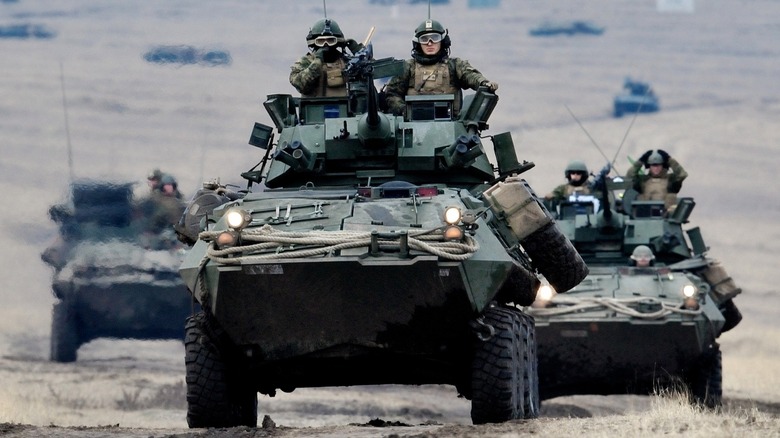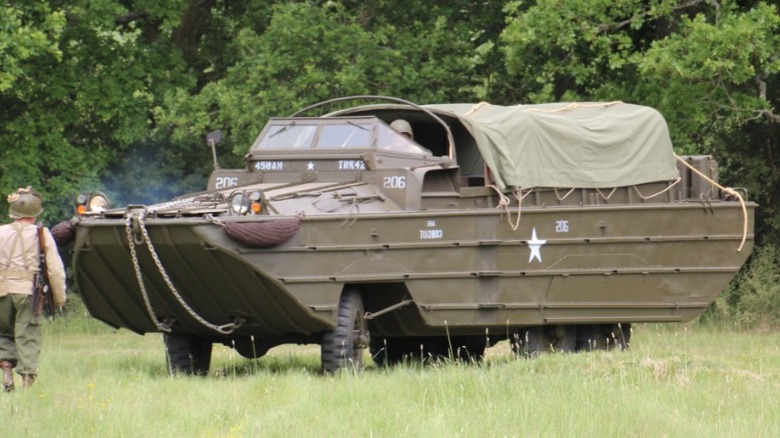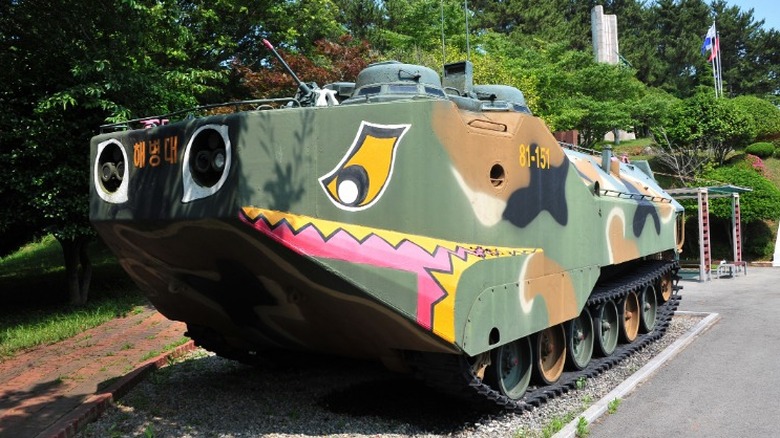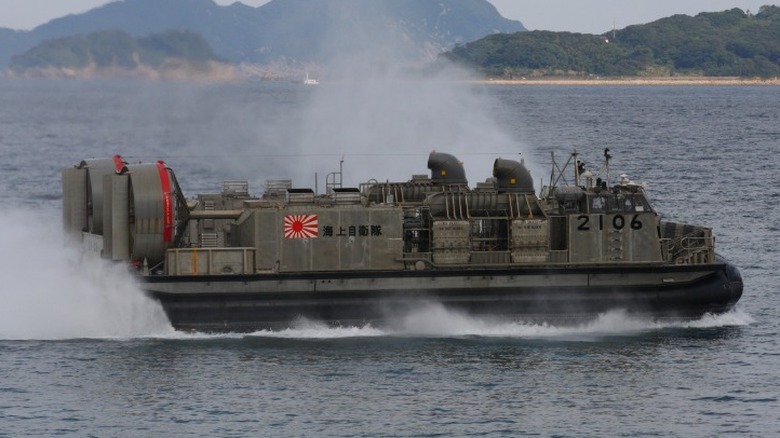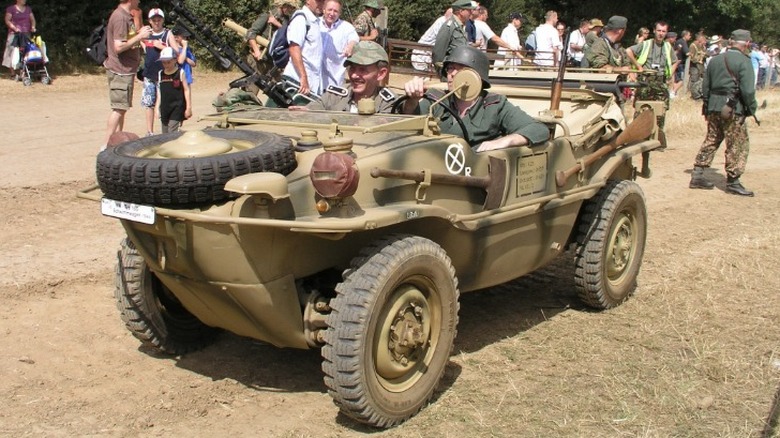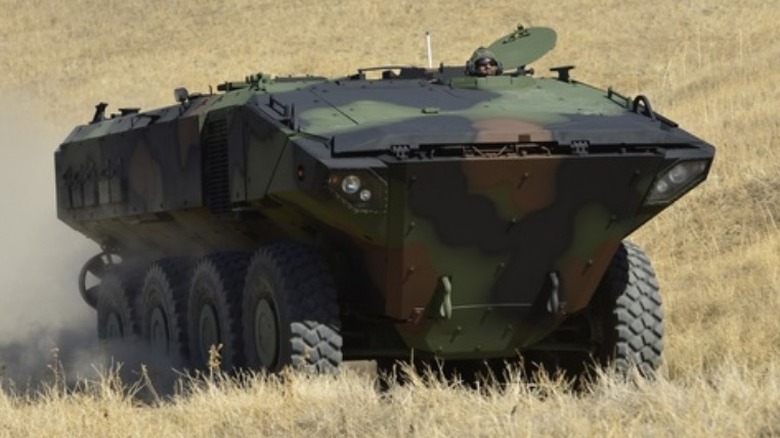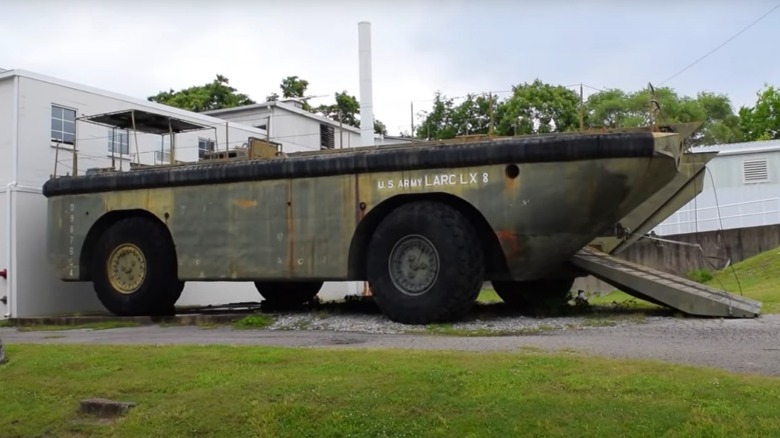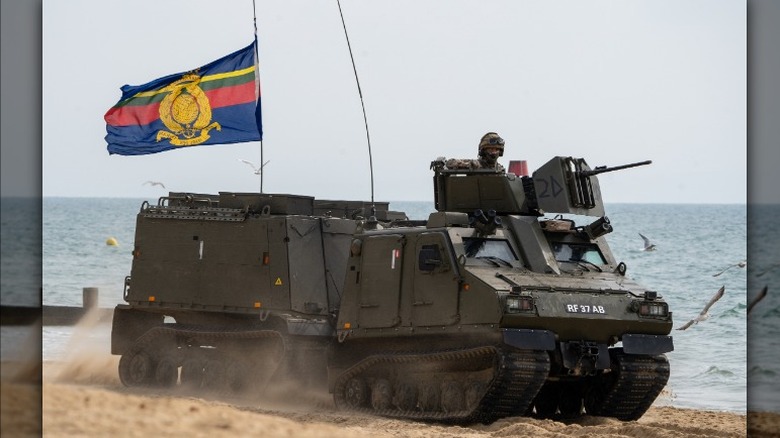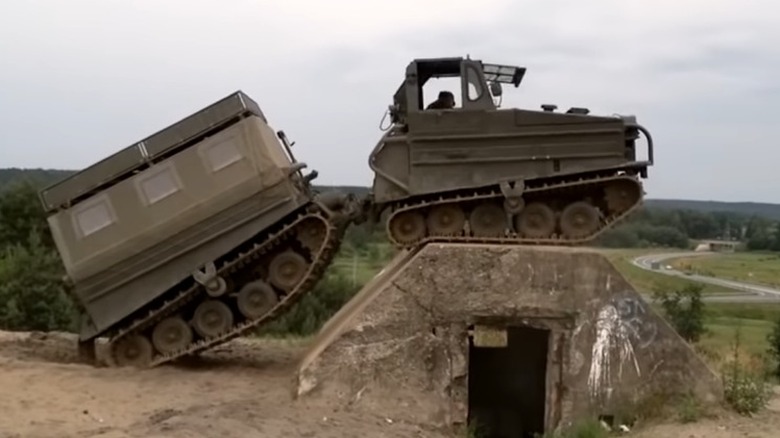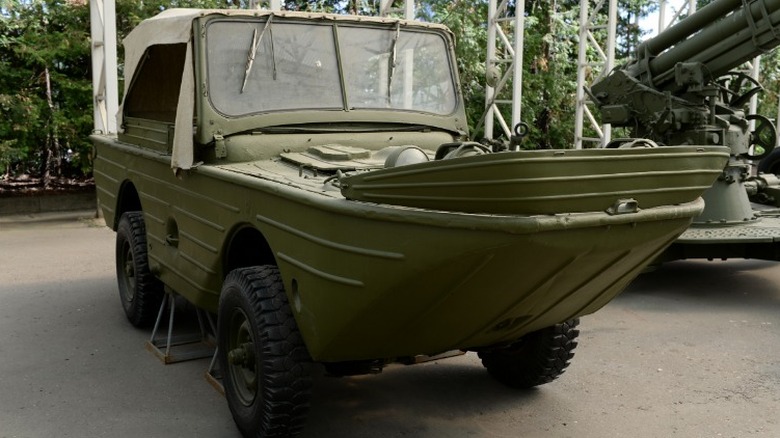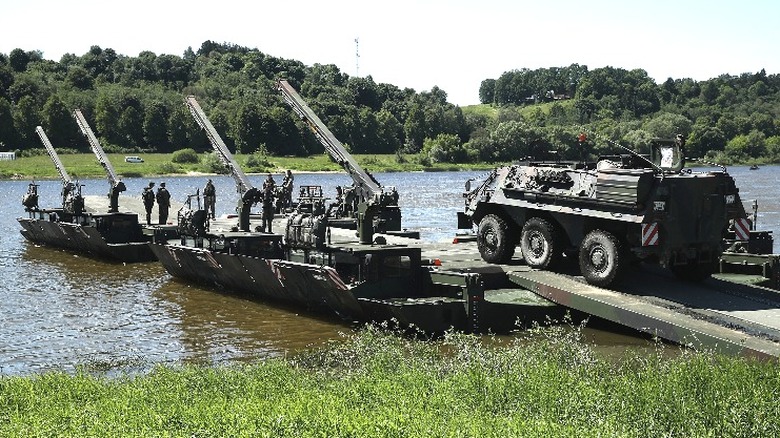10 Most Impressive Amphibious Military Vehicles Of All Time
Modern military conflict is rarely a straightforward engagement in which opposing armies face each other on the battlefield and march in the way wars had been conducted for centuries. Mechanized warfare brought with it the ability and necessity of attacking the enemy from any possible route. In the years following WWI, military leaders around the world sought to develop new fighting vehicles to give their troops an advantage in any way possible. The ability to approach hostile territory from the sea and gain access directly through the shore proved to be a valuable capability in the following years.
By the time WWII began, several vehicles from many countries were being built to traverse water and soil. These amphibious vehicles were built to aid in offensive operations moving troops onto shores, over rivers, and through wetlands in a single vehicle. Continued development of amphibious vehicles for transport and assault operations has resulted in vehicles of the modern day equipped with armor and armaments that rival other vehicles bound to the land or sea. Every modern military possesses these vehicles and the capabilities vary drastically from one to another. Looking back through the roughly 100-year history of amphibious military vehicles, these 10 are the most impressive.
DUKW
For American civilians in the modern day, the DUKW is probably the most recognized American amphibious vehicle. Often called a "Duck Boat", the DUKW is a six-wheeled vehicle built with the hull of a boat that offers excellent travel on the water and at least adequate travel over land. The chassis is a GMC 6x6 powered by a 269-cubic-inch, six-cylinder engine. While it only produced 94 horsepower, it was good enough for a top speed of 50 mph with an operational range of up to 400 miles over land. Propulsion through the water came from a single three-bladed propeller with a rudder for steering aided by the front wheels.
The DUKW's primary purpose was for transport, but some were equipped with cannons or rocket launchers to suppress fire while gaining access to the beaches. These proved to be invaluable to the invasions of Sicily and the many islands of the Pacific during WWII. Production began in 1943 and in the few years of operation during WWII, 20,000 had been produced and dispersed among American military branches as well as British and Soviet armed forces. These were decommissioned many years ago but can still be found in service by tour operators in popular travel destinations, including Boston, where they show tourists around popular colonial American historical sites.
LVT
Getting heavy armaments from sea to shore, especially in the days before heavy helicopters, has always been an arduous task. Supporting an expeditionary force such as the Marines with heavy firepower is necessary, and dragging howitzers and other heavy cannons from a landing craft while taking heavy fire is extraordinarily difficult and perilous. Therefore, the Landing Vehicle Tracked (LVT) was created by the United States Marines as a multi-purpose armored and armed amphibious vehicle.
The original design in the '30s developed into a vehicle capable of carrying cargo and troops along with mounted machine guns and was propelled by tracks that featured a patented oblique shape that also propelled the vehicle in water. This went through several variations throughout its service life and in 1956, resulted in the LVTP-5 amphibious armored personnel carrier.
The LVTP-5 saw extensive service during the Vietnam War. It was a large lightly armored vehicle with an expansive hull that was completely enclosed with enough space for around 20 soldiers or even a Jeep. They float mostly submerged and are capable of overcoming most rough terrain when emerging onto a beach, but their effectiveness dropped significantly once delivering troops to the front line — the 8mm armor was far too light to protect against most artillery fire. Most impressively, the Philippine Marines still operate these aged vehicles to this day.
Landing Craft Air Cushion
Although it is a subjective assessment, not too many would likely argue against calling the Landing Craft Air Cushion the coolest vehicle in the U.S. Navy's fleet. And for those not familiar with this name, it is a giant hovercraft. The LCAC is a powerful craft with immense capabilities that can be crucial to some missions when landing on the beaches and has recently undergone upgrades to extend the service life of existing units through the next decade.
Powering this immense vehicle are four gas turbine engines with a combined power output just shy of 16,000 horsepower. They spin a pair of directional fans on the rear for propulsion and four more directing air downward for lift. It stands 19 feet tall at rest but increases to 24 feet with the cushion inflated. It is rated to carry a 60-ton payload and can cruise at 40 knots (about 46 mph) when fully loaded, and its operating range with payload is 200 miles. Standard armament is two 12.7mm machine guns, but mounts can accommodate .50 cal machine guns, grenade launchers, and M-60 machine guns. The most impressive capability is that it can traverse 70% of shorelines around the world, providing a huge advantage over traditional landing craft that is limited to only 15% of coastlines with favorable terrain.
VW Schwimmwagen
While there is little to argue in favor of the political leadership of Germany during WWII, the engineers creating military machinery can be acknowledged for their ingenuity and the clever solutions they devised in building the machines to outfit the troops. The legacy of Volkswagen and its involvement in WWI is well-documented and the civilian Thing vehicle is directly related to the military Kübelwagen used during the war. But that military VW was also adapted for amphibious use as the Schwimmwagen, offering soldiers a robust and reliable small vehicle that helped to cross rivers and creeks throughout the war.
The Schwimmwagen looks a bit similar to the VW-based beach buggies of the late '60s, using the same frame and engine in the rear. It is all housed in a watertight tub with a small propeller in the rear, driven by a power takeoff connected to the transmission. The engine is located in a compartment in the rear with louvers in the lid providing airflow away from the waterline. To prevent damage to the propeller, it is attached with a hinged assembly allowing it to be lifted up away from the ground while on dry land and it can be lowered into the water from the driver's seat using a rod that extends over the rear decklid.
Schwimmwagens are durable and reliable vehicles that are equally capable on land and water. The front wheels provided steering in and out of the water, but reverse was only possible on land — paddles were included for reversing in water. With more than 14,000 units built before the end of the war, it was used extensively and has also led to it being a popular restoration project today.
Amphibious Combat Vehicle
The tracked amphibious vehicles used by the U.S. Marines for decades have been replaced by a similarly equipped vehicle, only this one rides on a set of eight 16R20 tire-wrapped wheels with power delivered to all of them. Produced by BAE Systems and delivered to the Defense Department around 2021, the Amphibious Combat Vehicle is powered by a 690-horsepower, six-cylinder diesel engine. It has a blast-resistant hull and energy-absorbing seats to increase occupant survival rates as well as the ability to be mounted with a variety of machine guns, including the M2 .50 caliber or grenade launchers. Its all-wheel-drive system is a sophisticated system optimized for providing the best possible traction on land and maneuvering in water.
One of its most impressive features providing a clear edge over the previous tracked vehicle is its top speed of 55 mph on land, however, the use of tires dramatically decreases speed in the water as propulsion is left only to a pair of propellers on the rear. With its 2021 delivery, extended operations in active combat zones have not yet taken place to put it to the test, but its modern design and sophisticated equipment suggest that it will be up to the task when called on by the Marines.
LARC-LX
While it entered service in 1952, the LARC-LX first saw use in 1967 during the Vietnam War. With hundreds of miles of coastline and a large portion of combat taking place very near the beaches, amphibious operations were integral to countless missions during the conflict. Among the vehicles used was the enormous LARC-LX, the largest amphibious vehicle ever created.
Most military vehicles are quite large, but the scale of the LARC-LX is difficult to convey in words. Listing the specifications may help to illustrate its size, though. This amphibious vehicle weighs in at 100 tons and is driven by four Detroit Diesel six-cylinder engines, one for each wheel. Combined output is 100 horsepower, and that propels it to a top speed of 15 mph on land or 7 knots on water thanks to a pair of propellers in the rear. It is 60 feet long and 26 feet wide, and the driver sits in a cab elevated from the ground at more than 20 feet. The payload capacity is 60 tons, which means it is capable of delivering tanks to the conflict zone, and that is indeed what it was used for. Payloads on this might be a combination of tanks, trucks, heavy artillery, or a couple hundred soldiers. To say its size is impressive might be an understatement.
While this giant has been retired from military service for many years, at least one lives on for public enjoyment. In 2005, Lane Motor Museum of Nashville had one transported from Florida and driven through downtown Nashville to reside as a permanent running display for the museum and is now a must-see attraction for all visitors to the Music City.
Viking BvS10
Equipment created for the Royal Navy and Royal Marines is second to none, and its amphibious Viking BvS10 is an interesting and unique example. This machinery is an amphibious tracked vehicle that possesses a unique characteristic in how it performs its duties. The bulk of its payload is carried in a separate section as part of an articulated setup. Both sections run on tracks and both can float as well, and steering is performed by hydraulic rams that change the angle between sections, allowing the tracks to continue driving forward. This makes it highly versatile as it can be changed for various mission parameters in short time and go from an attacking combat role to an ambulance role, for example.
All four tracks of the Viking are driven and are made of rubber, providing for high-speed driving and the capability of performing in nearly any environment. It is capable of operating in temperatures from -50 up to 114 degrees Fahrenheit and can be equipped with a wide range of weapons including machine guns and grenade launchers while its thick armor plating provides protection against armor-piercing rounds and artillery shell fragments. It is highly capable in snow and mud with the ability to ford up to 1.5 meters of water at any time and only requires a preparation time of two minutes for full flotation operation.
Bandvagn 202
Built by Volvo for the Swedish Army, the Bandvagn 202 (Bv202) is the predecessor to the British Viking. This was developed in the early '60s and produced through 1981 for use by the Swedish military but was also exported to Canada, Norway, Finland, and the U.K. While it was developed for use in Arctic conditions and is fully amphibious, its capabilities have led to its use in other climates, such as in the Middle East.
Like the Viking, it is an articulated vehicle running four rubber tracks but is powered by either a 1.8 or 2.0-liter Volvo four-cylinder engine. The wide rubber tracks are largely responsible for its excellent mobility on the snow, as it provides very low ground pressure by widely distributing its weight. It can also move from land to water without any preparation and the tracks propel while floating.
While it is only powered by small four-cylinder engines producing less than 100 horsepower, the Bv202 is an extremely capable and relatively small vehicle. In the vast expanses of snow-covered lands around the Arctic Circle, a small but tough vehicle like this is ideal to get over the snow and through the thick forest, and that is likely why this vehicle has lasted through modern day.
Ford GPA
After the U.S. entered WWII, the Jeep was one of the most prolific military vehicles in use by troops all across the conflict zones. As a companion, Ford was asked to create an amphibious version, which resulted in the Ford GPA. It used as many parts as possible from the original Willys Jeep to keep costs down and simplify production. These were powered by the same Ford four-cylinder engine and transmission, delivering 60 horsepower through the four-wheel-drive system with a power take-off for a screw propeller housed in a tunnel in the hull that kept it available at all times, but out of the way from obstacles on the road.
This vehicle was inspired by the DUKW and its success, and top brass wanted them produced to ferry troops from ship to shore. However, it was ill-suited for rough seas and too heavy on land. Most American troops did not care for it and many would call this a failure. But in the East, the Red Army took a liking to the GPA as their troops faced multiple river crossings on the way to Berlin and found the small amphibious Jeep perfect for the task. The Russians liked the GPA so much that after the war ended, they produced an exact copy called the GAZ-46 MAV. It could be said then that it was not a failure but was deployed in the wrong role and it did find success when put into service in the right elements.
M3 Amphibious Rig
Developed in Germany and used by several nations, the M3 is a highly agile mobile bridge and ferry rig that can ferry troops across rivers in minutes. When used in tandem with other units, the assembly of groups of M3s into a water crossing is an impressive feat to watch.
The M3 is driven by all four wheels on land and can reach speeds of up to 50 mph on land. It uses two hydro jets on the water that allow it to maneuver in any direction it needs. The jets are placed one on each end of the hull and rotate 360 degrees, allowing the giant craft to turn and swivel into place with surprising precision. It can deploy its pontoons while still on land and enter almost any unprepared surface into the water, transferring controls to the deck instantly. Once it is in the water, the wheels are tucked up into the hull and it can be connected to additional M3 Rigs to create a ferry or to still more units to create a bridge across even fast-moving rapids. With a properly trained team in place, two teams of four M3s can assemble a water crossing within 15 minutes.
Once assembled, 70-ton tanks can quickly and easily cross the river and head on to their objective. Once the crossing is complete, the powerful hydro jets allow the vulnerable unarmored M3 rigs to move downstream and out of harm's way. With the speed and precision this machine provides to a mobile force, a tank battalion can sneak up on the enemy before they even know what happened.
